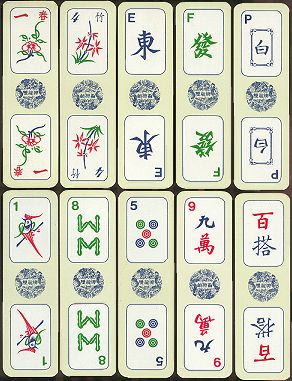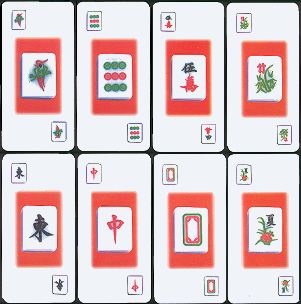This is a different kind of money-suited deck.
Mah Jong (though its real Chinese name is Ma Jue), is probably the most
common gambling game played throughout the country.
In spite of such popularity, it has two different spellings,
phonetically similar: the first one, used in the south (in the area of Canton and Hong Kong),
means "hemp sparrow", while the one used further north (Shanghai, Taiwan,
Peking) has the meaning of "hemp general". Apparently, none of these
names has a specific relation with the pieces, nor with the rules of the game.
Mah Jong is played by using a set of tiles, as the ones on the right,
but a deck of cards is a cheaper solution, and much easier to carry.
In fact, the first version of this game is said to have been played with cards, played in the streets and
in boats; but since wind caused problems during play, they were later replaced with
heavier and more solid tiles. |

Mah Jong tiles
|

Mah Jong deck by Double Dragon Brand (Hong Kong);
top row: Season 1 (Spring), Flower 4 (Bamboo), East Wind,
Green and White Dragons; bottom row: 1 and 8 of Bamboos,
5 of Circles, 9 of Characters and a wildcard ("100 purposes") |
The deck comprises 144 cards, as many as the tiles in a set, divided into three suits, given the Western names of
Circles (or Wheels), Bamboos (or Sticks) and Characters (or Myriads).
The original names of these suits are:
-
 tong ("tubes"
or "pipes") for Circles, graphically representing the section of a cylinder; tong ("tubes"
or "pipes") for Circles, graphically representing the section of a cylinder;
-
 suo
("strings"), or popularly suo
("strings"), or popularly  tiao
("long things" or "sticks") for Bamboos; tiao
("long things" or "sticks") for Bamboos;
-
 or or  wan
("myriads, 10,000") for Characters, which is the same wan described in
page 1, which in cards is more often spelt with the common glyph, especially in modern editions. wan
("myriads, 10,000") for Characters, which is the same wan described in
page 1, which in cards is more often spelt with the common glyph, especially in modern editions.
In Mah Jong only one out of three suits, namely Circles, does not fully match the corresponding one
belonging to standard money-suited cards, i.e. Coins (or Cash), but the graphic resemblance is still quite evident.
Also in the Mah Jong pattern the Myriads suit is the only one in which values
are shown by means of numerals, not by pip arrangement.
|
Instead, some distinctive features are:
- the 1 of Bamboos, featuring a bird, more often a sparrow;
- the four Winds, represented by means of their respective
directions:
 Dong (East), Dong (East),
 Nan (South), Nan (South),
 Xi (West)
and Xi (West)
and  Bei (North); note that in
the game of MahJong the main direction is East, and South is located on its right
(not on its left, as in a Western compass card); Bei (North); note that in
the game of MahJong the main direction is East, and South is located on its right
(not on its left, as in a Western compass card);
- the Red Dragon (
 Hua Zhong,
"inner red", whose second glyph is featured on the card or tile), referring to the animal world; Hua Zhong,
"inner red", whose second glyph is featured on the card or tile), referring to the animal world;
- the Green Dragon (
 Qing Fa,
"green emission", whose second glyph is featured), referring to the vegetable world; Qing Fa,
"green emission", whose second glyph is featured), referring to the vegetable world;
- the White Dragon, (
 Bai Pi,
"white skin"), referring to the spiritual world. This subject sometimes looks like
a blank piece, but more often it comes in the shape of a rectangular frame, either blue or green and red. Bai Pi,
"white skin"), referring to the spiritual world. This subject sometimes looks like
a blank piece, but more often it comes in the shape of a rectangular frame, either blue or green and red.
The Winds and Dragons are honours. |
|

single-ended Mah Jong cards (by Effect Company, Hong Kong);
top row: Season 1 (Spring), Flower 4 (Bamboo), the three
Dragons (red, green and white); bottom row: East Wind,
1 and 8 of Bamboos, 5 of Circles, 9 of Characters |
Each suit runs from 1 to 9, as in any classic money-suited pattern, but Mah Jong decks
or sets contain the aforesaid honours: three different Dragons (White, Red and Green Dragon) and
four Winds (East, South, West and North).
Each subject is repeated four times.

large size Mah Jong cards (Winner brand, Hong Kong);
the last card on the right, bottom row, is a wildcard |
The deck is completed by eight more special subjects, known as the four Seasons and
the four Flowers i.e. Plum, Lily, Bamboo and Chrysanthemum (in some editions, the
last two are in reverse order), variously depicted; unlike all values and honours
previously described, each of these eight pieces is single.
Some editions of the deck also have a further wildcard, repeated four times, which may be
used as any subject the player prefers (i.e. as a Western joker). It usually features
two characters which read "100 rides", meaning "multi-purpose card".
These cards are only used in some areas of the country, particularly around the city of
Shanghai.
A further type of "extra cards" may feature animals: a rooster, a mouse, a cat and a worm. They are very seldom found in tile sets or card decks made in China, being more typical in editions from Malaysia and Singapore. |
Lastly, there are editions with a double set of Seasons and Flowers (i.e. four sets with four cards each), whose subjects may vary.
|
In Mah Jong decks the value of each card may be shown
either in a white tile-shaped rectangle on a background of slightly different colour,
or may be freely drawn in the center of the card. The former variety is double-headed,
while the latter is single-headed, and usually features small indices in two corners
(players have to hold 13 of these cards in hand).
Unlike any other money-suited pattern, Mah Jong decks exist both in "Chinese-sized"
editions, i.e. with long and thin cards, and in large ones, slightly smaller than the size
of a Poker or Bridge deck, but with a similar shape. In this case the values are always shown in the center, either
in a tile-shaped rectangle (as in the previous picture, and in the one on the right) or,
more often, over a plain white background (as in the picture below).
|

large size Mah Jong edition, featuring pictures of a
set of tiles; by GuoGuong ("national pride") company, China |

large size Mah Jong cards by KR Brand (Hong Kong) |
Also the backs of Mah Jong cards differ from most other Chinese patterns: they are
among the few decks which do not have plain ones, of one same colour, but feature
geometric textures, as Western cards; some editions made in Malaysia even feature
advertisements.
The full set of tiles and the rules for Mah Jong can be
found in Steve Willoughby's Mah Jong
page.
|
The differences between this pattern and the ones described so far are:
- four suits, instead of three;
- the absence of a Coins or Cash sign, replaced by a second string-related suit;
- each card's value is stated by a peculiar symbol, above the Chinese character
which features the suit's name (no pip arrangement);
- every card is single (no duplicated values).
These elements of discrepancy with other Chinese cards, instead, are shared with
the four-suited Vietnamese cards (described in the Vietnamese gallery).
|

the Li Ten and Li Fa cards,
edition by Da Fa Cai, Hong Kong |

Hakka card symbols and matching values
(by courtesy of Dylan W.H.Sung) |
Most of the peculiar symbols indicating values (a few of which curiously
remind us of Western Spades, Diamonds and Hearts) have graphic resemblance with
ordinary Chinese numerals, as shown by the picture on the left. The use of
symbols in place of numerals might be due to the need of easily recognizable
shapes so that the many people with a scarce knowledge of the written language,
such as peasants, could play the game as well as others. |
A curious detail of the Hakka pattern is that value 2 appears
as a Spades-like symbol, in which a small Chinese character is featured, different
in each of the four suits: all together, they form the text "large character paper
cards", as in the picture on the right. This reminds us that the Chinese word for
"playing card", pai, also means "playing tiles", therefore the material
has to be specified, as well. However, to spell this expression, the four 2s have to
be arranged differently from the ordering based on the suits' usual hierarchy in play.
Since in some editions this text appears in full length also on the deck's paper wrapper,
it is likely to be a second common name locally used for this pattern. |
|

the 2s of the four suits, resembling Western Spades:
all together they read "large character paper cards"
(edition by "Double Happiness" Brand, China) |
The main game played with these cards is Liuk Fu (or "Six Tigers").
The full deck and the rules of the game are illustrated in Dylan W.H. Sung's How to Play Hak Ga Luk Fu Pai.
go to